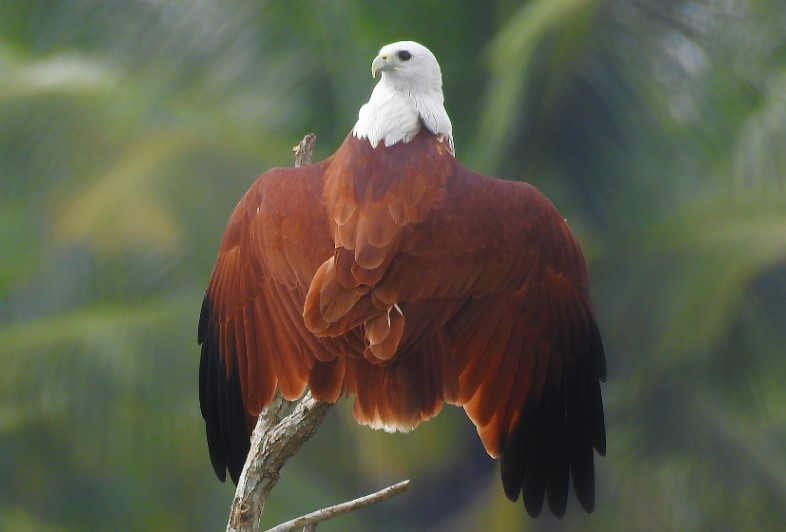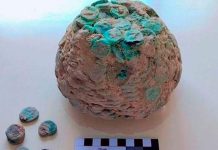Brahminy Kite or (Red-backed Sea Eagles) are likely to be found in northern Australia along inlets and bays with mangroves, scavenging around gardens and crops. Live prey is rarely taken, instead relying on fish and other marine animals that have been stranded or cast up by the tide. Aside from offal and scraps, it also catches live frogs, crabs, snakes, and insects, even if they are small. Small prey is carried to a perch for despatch if they are not taken on the ground and eaten there.
Live animals of large size cannot be killed by the Brahminy Kite. Usually less than 50 meters above the ground, Brahminy Kites quarter their foraging grounds in low tight circles while searching for food. These birds have straight, horizontal wings – along with short, square tails – that give them a bat-like appearance.
Their breeding is solitary, they pair only for breeding, and they never gather in flocks or roost communally as they do in India. It seems that each bird patrols its own stretch of shore, using highly exposed perches in living or dead trees as resting and surveying areas. There may be several months between courtship and copulation before nesting.

Displaying pairs soar over the nest site and perch in tall trees, calling at intervals; occasionally they also join to clasp feet in midair and come whirling down for l00 meters or more. The female does virtually all incubating and brooding while the male hunts and brings food to her, calling her off the nest to feed and pass food to the chicks. As the young grow and learn to feed themselves, from about three weeks of age, both parents hunt, returning only briefly to drop food at the nest.
Brahminy Kites are approximately 460-510 mm in length. Both sexes are similar, however, the female is a bit larger. White is the color of the head, neck, and mantle; chestnut is the color of the shoulders and back. Dark chestnut flight feathers, duskier primaries. Tail chestnut with white tips on all feathers except the outermost ones.
The underparts are white, except for the belly, undertail, and thighs, which are dark chestnut in color. Dark chestnut is the color of the underwing coverts. The eyes are brown to reddish brown in color. With a pale blue base and a cere cream-colored bill, the bill is pale blue-green to the bone in color.
Cream-yellow feet are paired with dusky claws. Birds’ immature heads and mantles are brown with cream streaks; shoulders, backs, and rumps are brown with rufous tints, flecked with cream. Primary wings are black; secondary wings are brown; and below, the wings are lighter. Two of the outermost feathers of the tail are cream, except for the dark brown tip. There are cream streaks on the underparts, which are brown-tinged red.

The belly and vent color is cream. Brown is the color of their eyes. The bill is dark grey, often tinged with olive. There is a cream color on the feet. DOWNY YOUNG: White with brown back and buff streak around neck and crown. Pee-ah-h-h, kee-e-yeh, and meowing mmmm-a are the calls of Brahminy Kites. Emits harsh wheezy squeals and mewing whistles when excited or protecting nests. Except when breeding, they are usually silent.
Breeding and nesting occur from April to October during the dry season, occasionally in January and February as well. The nest is made of twigs and sticks with a diameter of 400-600mm, lined with leaves, weeds, and paper or cloth litter. Nests are placed in vertical forks up to 18 meters above the ground. Kites lay one to three eggs, usually two; they are matt white to pale blue in color, finely streaked, and blotched with brown.
Eggs are oval to rounded-oval in shape and approximately 53 x 41 mm in size. Incubation takes about 26-27 days, almost exclusively for females. It takes about 50-55 days for the young to fledge, with only one usually surviving. As for distribution, the Brahminy Kite is found along the coast and offshore islands of northern Australia between Shark Bay, WA, and Hastings River, NSW. It is also found on mud flats, rocky shores, and beaches.
A few individuals have been found in inland streams and rivers. The bird, however, is sedentary or locally nomadic. Indonesia, New Guinea, and the Solomon Islands are also located in India and southern China. A small race with an unstreaked white head and bone bill live in Australia and New Guinea. Read More – Mississippi Kite Call







